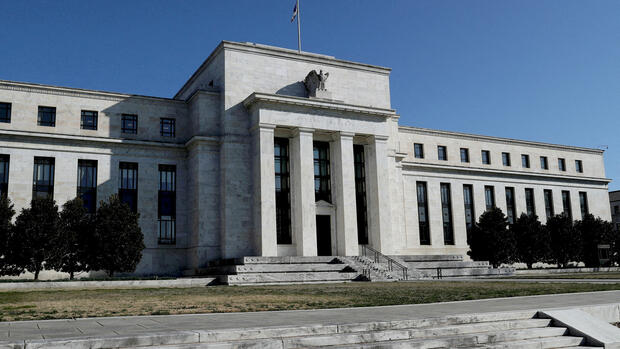new York The US Federal Reserve (Fed) has kept interest rates stable for the first time after ten consecutive hikes. At the end of the two-day meeting, the Federal Open Market Committee decided not to raise interest rates and left the key interest rate unchanged in the range of 5.0 to 5.25 percent. This was announced by the Fed on Wednesday evening in Washington.
The decision was unanimous. Monetary policymakers, however, braced investors for fresh rate hikes. There could be two more interest rate hikes this year, according to the Fed’s economic forecasts, which were also published on Wednesday. The currency watchdogs thus signaled a sharper course than many investors had expected.
At first, this spoiled the mood among investors. The Dow lost around one percent within a few minutes. The tech-heavy Nasdaq also fell initially, but then turned positive again.
The interest rate pause was largely expected. However, with its intention to raise interest rates twice more this year, the Fed is creating new uncertainty. Economists at Citigroup expect rate hikes in July and September. But Fed Chair Jerome Powell did not want to commit himself on Wednesday. He also left open whether interest rates could normally rise by a quarter of a percentage point or more. However, almost all central bankers would expect “slightly higher interest rates”, Powell clarified.
The interest rate pause was necessary to “gather additional information and to assess the impact of the rate hikes on monetary policy,” emphasized the Fed head. “Especially given how quickly and how far we’ve hiked rates,” Powell said. It takes around 18 months for the full effects of interest rate hikes to unfold in the economy, as economists have repeatedly pointed out in recent weeks.
Still a long way from the two percent target
Powell operates in a difficult economic environment. The inflation rate moderated markedly in May, data released on Tuesday showed. Consumer prices rose by 4.0 percent compared to the same month last year. In the previous month, the rate was still 4.9 percent.
The impact of interest rate moves on monetary policy is to be assessed.
(Photo: Reuters)
The current rate is the lowest since March 2021, however, inflation is still a long way off the Fed’s 2 percent target. However, the so-called core inflation, which does not take energy and food prices into account, is declining only slowly: this indicator fell from 5.5 to 5.3 percent. “As such, the Fed cannot yet be certain that it has done enough to fight inflation,” said Brian Coulton, chief economist at analyst firm Fitch.
Other developments also speak for the need for further interest rate hikes: the stock markets have recovered quickly from the strict monetary policy in recent weeks. The broad S&P 500 is back in a bull market after significant losses over the past year.
That means prices are up more than 20 percent since the most recent bottom. The rally was mainly driven by tech stocks and developments related to artificial intelligence (AI).
Small investors in particular returned to the markets in May. They’ve stocked up the most in the past month since it was 13 years ago, according to data from Morgan Stanley. However, this is counterproductive for Powell’s fight against inflation. The same applies to house prices, which have recently risen again slightly.
Wall Street expert Koch: Is US monetary policy about to end interest rate hikes?
Overall, monetary policymakers are somewhat more positive about the US economy than they were in March, when the previous economic projections were published. On average, they assume that gross domestic product will increase by one percent by the end of the year. In March, the forecast was still 0.4 percent.
The unemployment rate could also rise from the current 3.7 percent to 4.1 percent. In March, monetary policymakers had still assumed 4.5 percent. The inflation rate is expected to fall to 3.2 percent by the end of the year. “We’re not there yet,” Powell stressed, “particularly in terms of core inflation, which is a better indicator for us.” So the risk of the Fed not raising rates far enough is still greater than that risk of doing too much.
Cautious monetary authorities
According to the Fed’s statement, the economy will continue to grow at a moderate pace. However, the banking crisis in March, in which a number of regional banks had to be sold off, made the currency watchdogs cautious.
Torsten Slok, chief economist at the private equity firm Apollo, spoke back in April of an incipient credit crunch as a result of the banking crisis. However, the exact effects are not yet clear, Powell said on Wednesday. But the more difficult access to credit for households and companies was one of the reasons for the interest rate pause.
Not all experts approve of the Fed’s activism. The central bankers would go too far and “break something” if they hiked interest rates twice as announced, said Jeffrey Gundlach of DoubleLine Capital on the US stock exchange broadcaster CNBC. He assumes that the economy will weaken significantly in the coming months and that further interest rate hikes will therefore no longer be necessary.
On Wednesday, the majority of US investors assumed that there would only be one further interest rate hike. In recent months, they have repeatedly cast doubt on the Fed’s forecasts. In the spring, the majority of investors were still assuming that the Fed would cut interest rates by the end of the year. However, this is no longer the case.
More: The US inflation rate falls to 4.0 percent
